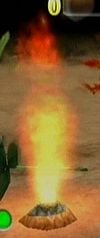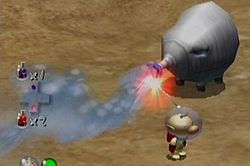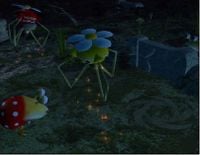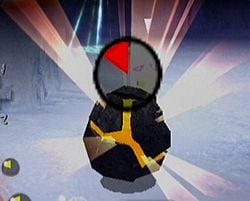Hazard
The term hazard in the Pikmin games refers to anything that can harm or kill Pikmin, including the creatures, non-living traps and other dangers of the Pikmin planet. In general, hazards are merely concepts, not objects, i.e. a hazard is the potential danger, not the object that actually emits the danger. Pikmin 2 also lists the existing hazards on its sunset menu screen. All types of hazards are listed below.
For hazards that affect the top of a Pikmin's stem – fire, water and poison – any Pikmin under the effects of that hazard will run around in panic. If they are not rescued after some seconds, they succumb to the hazard and die. They can be saved by being whistled. Interestingly, if a Pikmin is under the effects of an ultra-spicy spray, it will take half the amount of time for the suffering Pikmin to die.
Fire

- Main article: Fire.
![]() Pikmin cannot resist fire, except for Red Pikmin and Bulbmin. Fire usually appears as torrents of flame spat by fire geysers and some enemies, although there are also enemies that have a fiery body.
Pikmin cannot resist fire, except for Red Pikmin and Bulbmin. Fire usually appears as torrents of flame spat by fire geysers and some enemies, although there are also enemies that have a fiery body.
Water

- Main article: Water.
![]() Water hazards include all pools of water in the world of the Pikmin, as well as globs of water thrown directly at them. Pikmin that fall into the water will start to drown, but may have a chance to survive if they are repeatedly called over. Blue Pikmin and Bulbmin are not affected negatively by water.
Water hazards include all pools of water in the world of the Pikmin, as well as globs of water thrown directly at them. Pikmin that fall into the water will start to drown, but may have a chance to survive if they are repeatedly called over. Blue Pikmin and Bulbmin are not affected negatively by water.
Electricity
- Main article: Electricity.
![]() Electricity is a dangerous hazard in Pikmin 2, but barely harmless in Pikmin 3. Pikmin that get zapped in Pikmin 2 die instantly, while Pikmin in Pikmin 3 are sent into a paralyzed state, until they're whistled back up. Some enemies and obstacles emit electrical currents, and there are electric gates that have a constant stream of electricity. Yellow Pikmin and Bulbmin are immune to electric shocks.
Electricity is a dangerous hazard in Pikmin 2, but barely harmless in Pikmin 3. Pikmin that get zapped in Pikmin 2 die instantly, while Pikmin in Pikmin 3 are sent into a paralyzed state, until they're whistled back up. Some enemies and obstacles emit electrical currents, and there are electric gates that have a constant stream of electricity. Yellow Pikmin and Bulbmin are immune to electric shocks.
Poison

- Main article: Poison.
![]() Poison is hazardous gas that Pikmin cannot breathe. If they come in contact with such a gas, the top of their stems will be shrouded in gas, and they will begin choking. Some obstacles and enemies can emit clouds of poison gas. White Pikmin and Bulbmin can breathe through poison gas, however.
Poison is hazardous gas that Pikmin cannot breathe. If they come in contact with such a gas, the top of their stems will be shrouded in gas, and they will begin choking. Some obstacles and enemies can emit clouds of poison gas. White Pikmin and Bulbmin can breathe through poison gas, however.
Other hazards
Although not commonly considered hazards like the four elemental ones, the following dangers also exist.
Explosion
- Main article: Bomb rock.
![]() Bomb rocks explode, and any Pikmin caught in the blast will die instantly. In Pikmin and Pikmin 3, Pikmin can carry and throw the bomb-rocks at enemies, making explosions both a tool and a danger. Any deaths caused by the attacks of a Gatling Groink or Man-at-Legs count as explosion deaths, not as deaths from an enemy.
Bomb rocks explode, and any Pikmin caught in the blast will die instantly. In Pikmin and Pikmin 3, Pikmin can carry and throw the bomb-rocks at enemies, making explosions both a tool and a danger. Any deaths caused by the attacks of a Gatling Groink or Man-at-Legs count as explosion deaths, not as deaths from an enemy.
Blunt force
- Main article: Blunt force.
This icon is used to represent crushing hazards on the wiki. Some obstacles and enemies can crush Pikmin and leaders. This is fatal for Pikmin that are not Rock Pikmin. Another type of blunt force exists in the form of stabbing.
Pit
- Main article: Pit.
![]() This refers to the pit outside the boundaries of every sublevel of every cave, as well as the bottomless pit in The Forest Navel; if Pikmin are thrown over the edge of the level or leave its walls or floor by a glitch, they fall to their deaths. Enemies can be killed by this as well, a strategy that can be used to one's advantage.
This refers to the pit outside the boundaries of every sublevel of every cave, as well as the bottomless pit in The Forest Navel; if Pikmin are thrown over the edge of the level or leave its walls or floor by a glitch, they fall to their deaths. Enemies can be killed by this as well, a strategy that can be used to one's advantage.
Enemies
- Main article: Enemy.
![]() As the most common hazard, enemies play a major antagonistic role in game. The vast majority of beasts can harm Pikmin in some way, be it by eating them, rolling over them, sucking them up, or crushing them. Some produce other hazards, including fire, water, electricity, poison, bomb-rocks and boulders. Some even blow Pikmin away into other hazards.
As the most common hazard, enemies play a major antagonistic role in game. The vast majority of beasts can harm Pikmin in some way, be it by eating them, rolling over them, sucking them up, or crushing them. Some produce other hazards, including fire, water, electricity, poison, bomb-rocks and boulders. Some even blow Pikmin away into other hazards.
Enemies that are harmless to Pikmin, and even often beneficial, can be found here.
Sunset

- Main article: Sunset.
![]() At the end of the day. all Pikmin not in the landing area, with a leader, or planted in the ground, will die – they will be eaten by the aggressive beasts at night. It is possible to tell which Pikmin colors are killed during the cutscene of the ship lifting off by the Pikmin spirits that appear. Enemies can also be killed during this cutscene by White Pikmin or other enemies.
At the end of the day. all Pikmin not in the landing area, with a leader, or planted in the ground, will die – they will be eaten by the aggressive beasts at night. It is possible to tell which Pikmin colors are killed during the cutscene of the ship lifting off by the Pikmin spirits that appear. Enemies can also be killed during this cutscene by White Pikmin or other enemies.
Minor
- File:BubbleIcon.png Bubbles: Waddlepuses and Peckish Aristocrabs can release a stream of bubbles which capture Pikmin and leaders. They can be popped with a Pikmin throw or by themselves after some time. Winged Pikmin can be told to charge at a bubble, but if too many of them do it at once, the bubble will rise up to the sky at a ludicrous speed.
- Arachnode webs: Arachnodes create webs that can stay in the way of passing Pikmin. Winged Pikmin are especially prone to being caught.
- Ink: Toady Bloysters and Sputtlefish in Pikmin 3 shoot out ink which temporarily chokes Pikmin. This does not kill the Pikmin.
- Phosbat dust: The Vehemoth Phosbat can shoot out a dust that acts similarly to ink.
Names in other languages
Hazard
| Language | Name | Meaning |
|---|---|---|
| Danger | Hazard |
Bubble
| Language | Name | Meaning |
|---|---|---|
| Blase |
See also
| Hazards | ||||||||||||||
|---|---|---|---|---|---|---|---|---|---|---|---|---|---|---|
| ||||||||||||||
| Other hazards |

